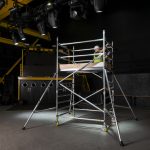In this article, Klaus Allion, managing director, ANT Telecom, discusses the different factors that businesses must consider when selecting a lone worker device, beyond the device itself, such as: environment, functionalities, cost and more. 
With more than six million lone workers within the UK, organisations of all sizes that employ staff that work alone have a responsibility to ensure their safety at all times. As such, lone worker devices are a vital resource when it comes to the issue of safety in the workplace. Without close supervision or contact from colleagues, the risk to lone workers is significantly increased as there are no other team members nearby to provide quick assistance in the event of an injury, illness or other emergency incident. Users rely on the devices to have a constant connection and work faultlessly, so that if an emergency occurs, they can trust in the technology to raise an alarm and it will be dealt with effectively.
However, when it comes to procuring a lone worker solution, there are increasing numbers of cheap lone worker products available, so how can businesses ensure that the solution they implement fully meets the employee requirements as well as business objectives? When it comes to selecting a solution, there are numerous factors to think about, not just the device itself.
The Working Environment
With lone workers in the UK spanning a multitude of industries, from logistics to healthcare, the first point to consider is the workplace that the lone workers operate in, to assess which features and format would be most suited. For example, a nurse visiting patients in their homes could benefit from a device on a tag. However, a tag device would not be suitable for a colleague working on a wind farm in the Highlands as there would be no GSM coverage. Furthermore, the device would also need to be ruggedised and operate at a high volume level in order to be useful in these conditions.
The employee’s role is also vital to take into account, for example, a lone worker in a factory environment would not benefit from an app that is incorporated into a smartphone, as they require hard wearing devices that can withstand being dropped and can be operated by someone wearing heavy duty or wet gloves. Thankfully, there are multiple options available so that every working environment could have a bespoke setup that is specific to the needs of the employees and the business as a whole. It’s therefore paramount to establish which would be the most suitable for each individual setting in order to optimise the device for users. This is also true for the changing needs of an organisation, with new roles or areas of the business the employee needs could vary considerably. As such, organisations should regularly review the employee and business requirements to keep on top of any changes, and address them rapidly if necessary.
Multi-functional Devices
In addition to the environment, another factor to consider is how employees communicate with the rest of their team, suppliers and customers. Lone worker devices can now be multi-functional and address additional communication challenges, as well as worker safety. Instead of carrying a number of devices that serve different purposes, functions such as comms, lone worker and messaging can all be integrated into the same device.
If a business has already installed a communications system, but without a lone worker function, instead of overhauling the whole setup the existing solution can potentially be enhanced to provide lone worker safety functionality. For some organisations this can be a cost-effective solution to the issue of lone worker safety.
Cost
For many organisations, cost can be a significant factor when it comes to procuring any new technology, so with an increase of cheap solutions that have entered the market from overseas, first time buyers could be easily swayed to select the cheapest option. However, when it comes to protecting workers’ lives, businesses must completely trust that a device has been fully tested and certified – a cheap device that has been bought online from overseas is unlikely to instil confidence in the workforce it is supposed to help protect. By working with a supplier that is an expert in the market, they can help to evaluate a business’ requirements in detail and recommend a suitable solution that fits their specific needs, and integrating systems where possible, rather than a ‘one device fits all’ approach.
Procedures
As well as having the right hardware in place, it’s just as important to implement the right protocols that employees must follow if a workplace incident were to occur. A vital part of the solution is how staff respond effectively to critical alarms raised by a lone worker – it must not be taken lightly. Alerts can be triggered by ringing a number or sending a text message, but how do you know that a recipient has actually read the message and is doing something about it? It is essential that alarms can be escalated up the chain until someone acknowledges the alert and manages the incident accordingly, especially when someone’s life depends upon it.




